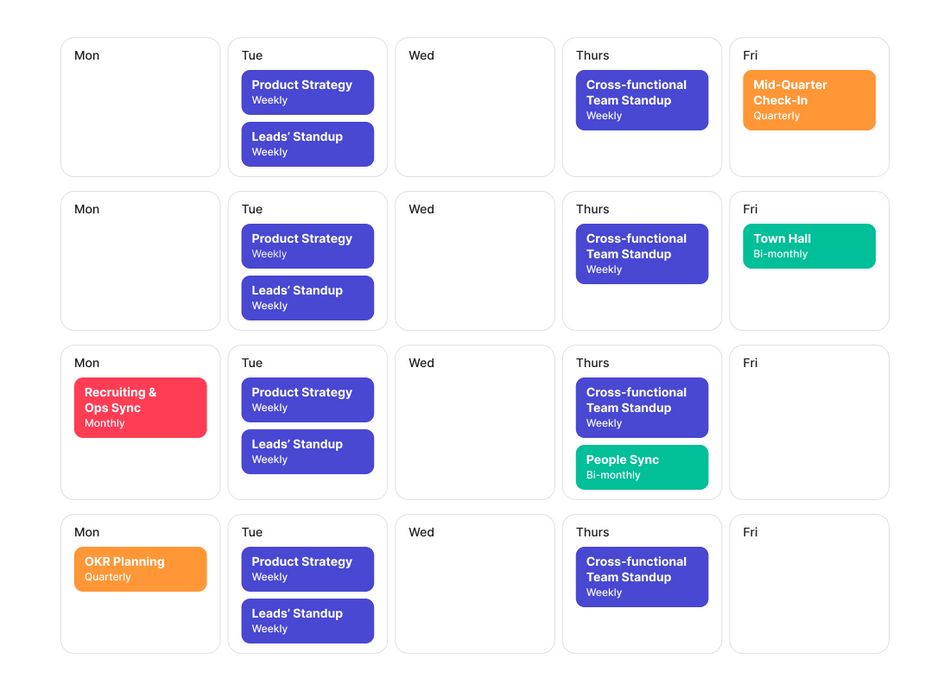Leading a team, especially a distributed or growing one, can be hard. Oftentimes the best advice and ideas come from other teams just like yours. That’s why we launched Lead Time: How Teams Work. This blog series profiles real teams, how they’re structured, and how they communicate through meetings and other touchpoints. Plus, each article features a top-notch leader who shares tips and advice for your team.
Meet Mariah Hay, Help Scout’s CXO
As Chief Experience Officer, Mariah Hay leads Help Scout’s engineering, product management and product design teams — a group of ~70 folks spread out between the west coast and Europe. They’re an all-remote product team, focused on humanizing the customer support experience — with a platform used by more than 12,000 businesses worldwide.
We sat down with Mariah to get her take on remote communication and meetings. She shared a glimpse at how her team operates and some sage advice on managing a growing, global remote team.
How the Help Scout experience org works
Team structure
The Help Scout experience org, which reports into Mariah, consists of functional leaders (the team’s head of eng, head of design, and head of product management) and cross-functional experience teams — each responsible for a different part of the product.
Team meetings and communication cadence

Daily
- Slack channels: Used for both asynchronous and real-time communication
- 4-hour overlap window: Product teams are arranged so everyone on a given team is able to be online at the same time for at least 4 hours a day — this helps make communication and quick collaboration go a lot more smoothly.
Weekly
- Leads standup: The heads of each function discuss operational updates and share info needed to run the business — updates are relevant across the experience org.
- Leads + co-founders: Discuss product strategy and infrastructure
- Experience team standups: Cross-functional product teams hold a video stand-up to share updates and work through blockers. Each team does these a little differently — for instance, some do daily check-ins over Slack paired with a weekly video meeting — and is encouraged to try new things.
Monthly
- Leads + cross-functional partners: Discuss recruiting pipeline and other cross-functional topics with the head of people, financial partner, and head of recruiting.
Bi-monthly:
- Town hall: The entire experience org gathers every 6 weeks to do deep dives, review metrics, and celebrate wins.
- People managers + product managers: Discuss ways of working and what can be improved to make the team run more smoothly.
Quarterly:
- OKR reflection and planning: Discuss what was shipped last quarter and what will be shipped this quarter.
- Mid-point check-in: Product managers meet with the co-founders to check in on how the team is tracking towards quarterly goals and adjust the product roadmap if necessary.
Mariah’s top tips for running a remote, global team
1. Create a rhythm of async and real-time communication
At Help Scout, Mariah says blending frequent async communication with occasional moments of real-time collaboration has been the biggest secret to keeping her remote team working effectively.
“For starters, we do a lot of written documentation,” says Mariah. Creating a written record of what’s going on is an easy way to keep track of in-flight work and progress towards goals — without constantly hounding folks for updates. For written documentation, Mariah’s team uses Dropbox Paper for project plans and one-pagers, Slab to keep everything organized in a team Knowledge Base, and Google Sheets to track OKRs.
“We have a very asynchronous culture,” shares Mariah. “Now we’re working on adding [real-time] communication practices back in where they make sense too.”
Her teams might share updates asynchronously and then discuss relevant pieces of them in real-time over Slack or video meetings. Since she leads several different experience teams, spread out across the globe, she gives each team autonomy to decide what works best for them.
One rule that stays consistent though: the 4-hour overlap window.
“When forming into our sub-teams, we try to arrange things so people have at least a 4-hour overlap with their teammates to bridge that gap,” explains Mariah. This gives folks flexibility, but also ensures they’ll be online at the same time as their team for a few hours each day to communicate, connect, and collaborate effectively.
2. Design your meetings the same way you design your products
As teams grow and evolve, meetings that worked for the group in the past can quickly become unwieldy or ineffective.
Since joining Help Scout, Mariah’s found many ways to revamp her team’s existing meetings using some of the same human-centered design approaches her team uses when designing the product.
“Think of your attendees as your users,” says Mariah. “And your meeting is your product.”
Just like you would when building a new product, Mariah recommends anchoring your meetings in user needs and goals.
“Ask: What’s our goal? What are we trying to achieve together? And what does everyone want out of this meeting?” she says. “Just like in user research, you’re trying to understand what folks need from their time together and what gaps exist today.”
For bigger meetings, it can be a little trickier to gain that level of alignment. Mariah says doing a survey can help.
Mariah’s meeting survey questions:
- Why do you attend this meeting?
- What do you hope to get out of it?
- What are you not getting out of it today?
- Are you having interactions outside of this meeting that you think should be happening in the meeting or vice versa?
3. Use pre-reads to skip status updates and make meetings more impactful
Help Scout holds a monthly customer feedback meeting attended by anyone who comes in contact with signals from their customers. This includes customer support, sales, marketing, and more.
“It’s a big freaking meeting,” says Mariah. “When I started it felt a little shiftless — so I decided to revamp it.”
She started by figuring out what everyone attending the meeting was looking for. Then, she drew some boundaries around what would and wouldn’t be covered in the meeting to maximize time together. Today, a big part of the meeting happens asynchronously — with a pre-read.
“It turned into a big, robust pre-read that we put a lot of time into beforehand,” she explains. “There’s so much good data in there every month — it’s great. Then, we can spend the meeting time just discussing nuances of things that we're hearing or patterns that really help drive the direction of what we decide to build.”
Mariah says pre-reads have become a common practice for most of the larger meetings she’s a part of — it’s a great way to align and share updates beforehand so that real-time conversation can be more focused on tackling issues and making decisions.
Use Mariah’s template to run your next customer feedback meeting







